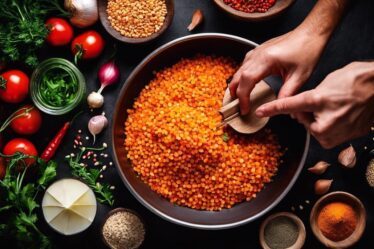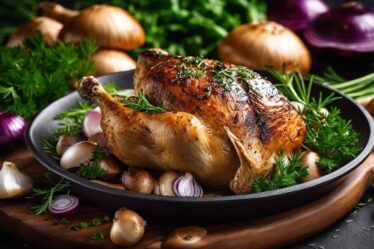
Identification
Hen-of-the-woods mushrooms, scientifically known as Grifola frondosa, present a fascinating appearance. Looking like the ruffled plumage of a brooding hen, this mushroom grows in large, sprawling clusters at the base of trees, especially oaks. Their grayish to brownish caps, sometimes tinged with white along the edges, sprawl outwards from a central, branching stem, creating a distinctive shelf-like structure.
Unlike many mushrooms that boast gills beneath their caps, Hen-of-the-woods feature unique tiny pores, which are critical to its correct identification. These pores are cream-colored and add to the mushroom's overall exotic aesthetic.
The absence of gills and presence of these pores are essential markers when distinguishing Hen-of-the-woods from lookalikes. The environment also plays a role in spotting these coveted fungi. They specifically favor hardwoods, attaching themselves to the base of living or sometimes even dead oak trees. Observing the associations between the mushroom and its environment offers a clue towards proper identification.
Additionally, Hen-of-the-woods tends to show up in the late summer to autumn months, often growing in the same location for multiple years if undisturbed. Spotting them requires a keen eye, as they blend well into the woodland floor despite their size.
On the table of lookalikes, Hen-of-the-woods stands firmly with distinctive traits separating it from potential imposters. It's uncommon to mistake it once you're accustomed to its appearance. However, a few others like the black staining polypore or the umbrella polypore bear passing resemblances but lack the Hen's elaborately layered and frond-like structure. Significantly, no poisonous mushrooms closely mirror the hen, making it one of the safer wild mushrooms for novice foragers.
The allure of Hen-of-the-woods goes beyond merely spotting in wooded alcoves; it crosses into the realm of culinary delight and health benefits. These mushrooms promise a savory addition to dishes and are loaded with nutritional value that amplifies their appeal. Yet the ultimate pleasure remains in the hunt – identifying and finally laying hands on these wild treats requires patience, an eagle eye and respect for the forests that produce them. Careful observation of their unique characteristics against the backdrop of lookalikes ensures both safety and the thrill of foraging success.
Culinary Uses
In the kitchen, Hen-of-the-woods is a versatile ingredient. Its robust structure and complex, earthy flavor make it cherished among culinary enthusiasts. Its hearty texture stands up well to cooking, which is why it's often heralded as a meat substitute in vegetarian dishes. Yet, this understates its true culinary potential, which spans from traditional Japanese dishes to modern gourmet cuisine where its unique flavor and texture shine.
In traditional Japanese cuisine, Hen-of-the-woods, or maitake, is often used in miso soup, stir-fried dishes, and as a component in sukiyaki. Its ability to absorb flavors while contributing its savory depth makes it a valuable addition to broths and sauces. The mushroom's natural glutamates elicit a strong umami character that enhances any dish's complexity without overpowering other ingredients.
In Western cuisines, Hen-of-the-woods can transform side dishes into the table's centerpiece. Roasted or grilled, the mushroom's fronds caramelize at the edges, delivering a delicate crunch followed by a succulent, meaty interior. A simple preparation might involve tossing it with olive oil, garlic, and rosemary, then roasting until golden brown. For something more daring, a Hen-of-the-woods risotto utilizes its woody undertones to complement Arborio rice's creaminess, creating a dish that's both comforting and sophisticated.
Its nutritional profile is as impressive as its flavor. Rich in proteins, antioxidants, and fibers, Hen-of-the-woods supports the palate and the body. This mushroom is packed with vitamins B and C, minerals like potassium, and it's believed to have properties that help manage blood sugar levels and boost the immune system—food as medicine.
However, its ephemeral nature means enjoying Hen-of-the-woods fresh can be limited to its growing season. Fortunately, their meaty texture and size lend well to preservation. Dehydrating mushrooms is a traditional method that suits Hen-of-the-woods. The dried product can be rehydrated for use in soups and stews, where it reclaims much of its original texture and flavor. Alternatively, sautéing and then freezing in portions ensures that this fall find can bring warmth to winter meals. For the more adventurous, pickling adds a tangy dimension that can elevate sandwiches, salads, and charcuterie boards.
From an elegant escort to seared steaks to the star of a vegetarian feast, Hen-of-the-woods spans the gamut of culinary uses. Its nutritional value and rich, savory flavor set it apart from other mushrooms, reinforcing its status as a forager's prize and a venerable ingredient in its own right. In the company of Hen-of-the-woods, every meal is an occasion, a celebration of the mushroom's evolved qualities from sight to plate—providing boundless opportunities for those willing to explore its potential.
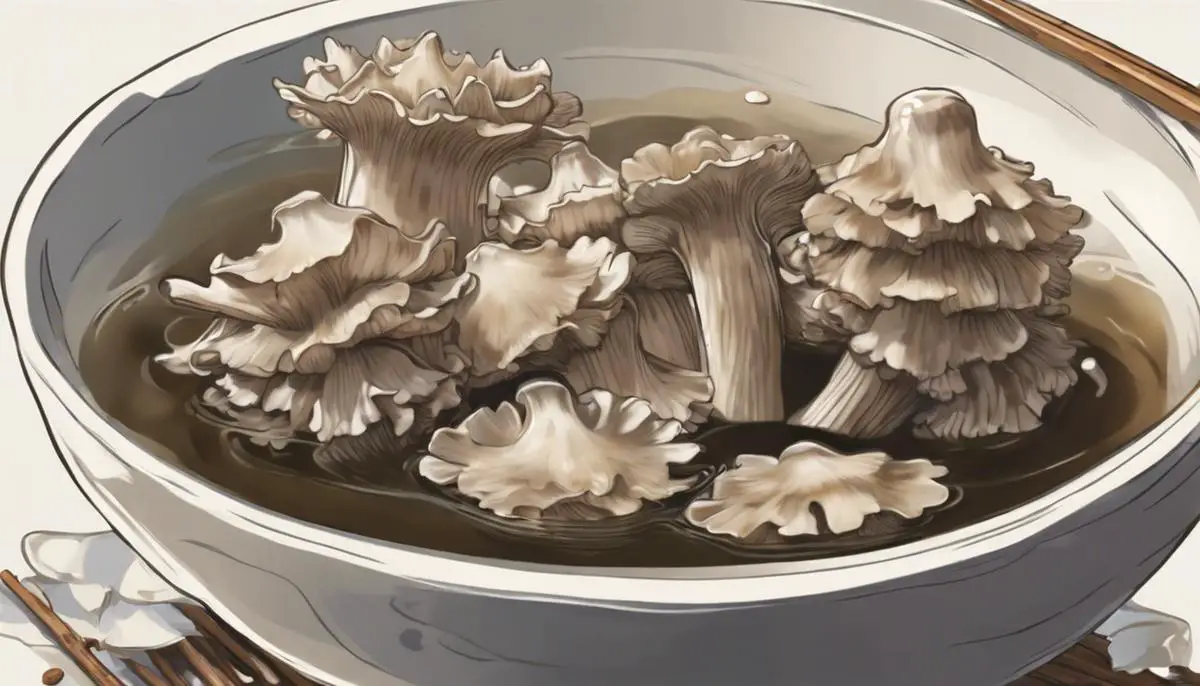
Foraging Tips
Embarking on a quest to find Hen-of-the-woods can be an experience filled with anticipation. Each step into the forest carries the promise of uncovering these culinary delights. However, success in this endeavor requires more than just enthusiasm—it demands a blend of knowledge, respect, and patience. Foragers equipped with practical tips are the ones who walk away with bountiful harvests while ensuring the continuity of these treasures for generations to come.
The prime time to forage Hen-of-the-woods is from late summer through fall, roughly August to November. This period is when the mushrooms are at their peak, both in size and nutritional content. To increase your chances, focus your search around mature oak trees. While they occasionally favor other hardwoods, old oaks are their preferred host. The mushrooms typically manifest at the base, blending into the woody debris and shadows, so keen observation is essential.
When you find yourself in a wooded area rich in oak trees, slow down. Take gentle steps and look around the base of each tree, especially those that show signs of age or stress. Such trees might seem less majestic, but they are natural sanctuaries for our fungal friends. Additionally, returning to a successful spot from a previous year can yield rewarding repeats—a testament to the Hen-of-the-woods' loyalty to its location.
Ethical foraging practices are integral to preserving both the mushroom populations and their habitats. The first rule is to take only what you need. Overharvesting not only depletes local resources but can also prevent the mushroom from regenerating in the future. Use a knife to cut the mushroom at its base rather than pulling it out. This method minimizes damage to the mycelium, the intricate web of fungal threads from which mushrooms emerge, ensuring more seasons of sustainable harvesting.
Equally important is to tread lightly in the forests. Stick to existing paths as much as possible to avoid trampling over unseen flora or disturbing wildlife habitats. Always remember that forests are communal spaces shared with countless living organisms.
Sharing your foraging spots might feel like giving away a cherished secret, yet fostering a community of mindful foragers can help spread the ethos of responsible harvesting. Teaching others about the importance of conservation and ethical practices contributes to a collective effort of safeguarding our natural treasures.
Patience is your ally. Not every foray into the woods will end in success, and that's okay. Part of the enchantment of foraging is the experience itself—the quiet whispers of the forest, the fresh air, and the connection with nature. Hen-of-the-woods foraging is not just about the harvest; it's a journey that immerses you in the mystery and beauty of the woodlands.
As we venture into the realm of fungi, embarking on mushroom forays with respect and wonder, we become not just foragers but stewards of nature's gifts. So, when you set off on your next adventure in search of Hen-of-the-woods, remember that you're partaking in an age-old dance with nature—one that calls for understanding, finesse, and reverence for the wild.
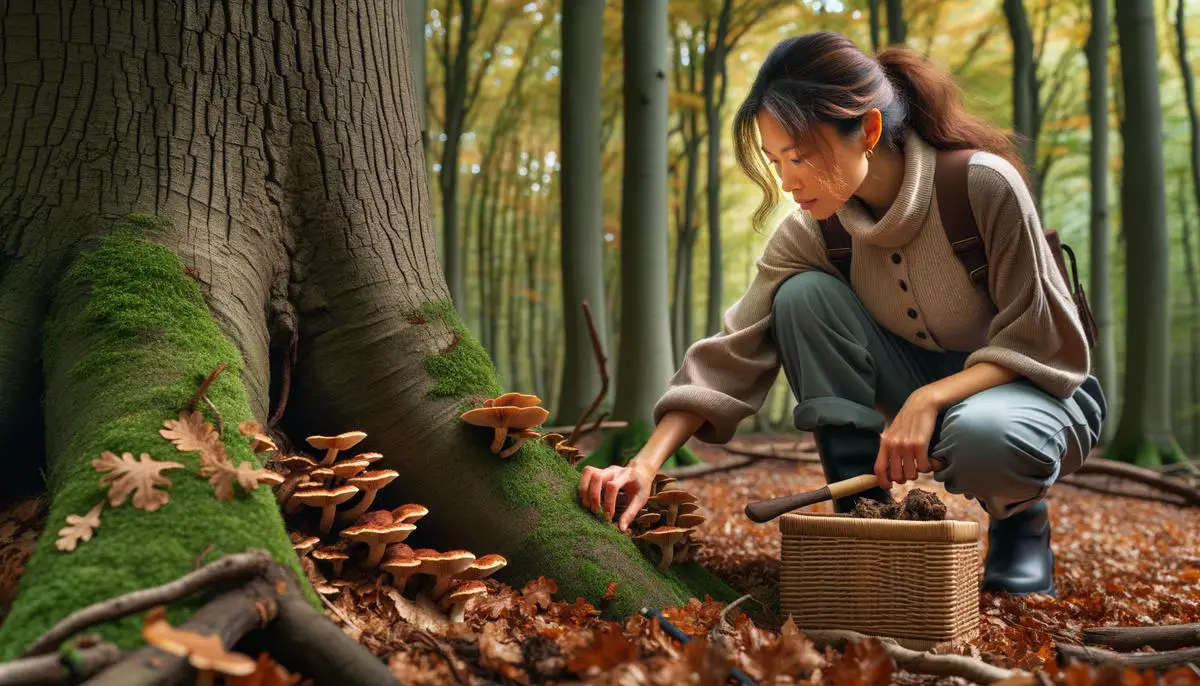
Medicinal Properties
The Hen-of-the-woods mushroom transcends from a staple in culinary circles to a beacon of health and vitality, underscoring nature's brilliance in crafting substances that nourish and heal. The reverence for Maitake in traditional medicine, particularly in Japan and China, stems from its apparent immune-modulating abilities, encapsulated within its complex biological framework. Embracing both folklore and modern science, we uncover a fascinating narrative that elevates this mushroom from the forest floor to the forefront of holistic health.
Foremost amongst its accolades is the Hen-of-the-woods' reputed capacity to bolster the immune system. Scientific explorations into this realm reveal that the mushroom harbors beta-glucans, potent polysaccharides that act as immunomodulators. These molecules navigate the intricate web of immune responses, enhancing the body's defense mechanisms against pathogens. Thus, consuming Hen-of-the-woods doesn't just tantalize the taste buds; it potentially strengthens the body, rendering it less susceptible to illness.
The dialogue surrounding Hen-of-the-woods and cancer is both hopeful and hedged with caution. Research punctuates its conversations with findings suggestive of the mushroom's anti-cancer properties—pointing towards its potential not just in complementary cancer care, but in the supportive embrace of those journeying through the battle. Nonetheless, science insists on prudence; these findings are initial whispers of possibility, not yet loud proclamations of certainty.
Moreover, Hen-of-the-woods steps into the limelight with claims of aiding metabolic health—improving blood sugar regulation and potentially influencing cholesterol levels. For those navigating the challenges of diabetes or grappling with metabolic syndrome, these properties cast the mushroom as an intriguing supplemental ally. However, the call for balanced consumption is paramount, lest enthusiasm overshadows the necessity for comprehensive care under professional guidance.
In addressing the medicinal virtues of Hen-of-the-woods, it's crucial to weave a tapestry that recognizes the complexity of human health. Traditional wisdom, bolstered by scientific inquiry, renders this mushroom a compelling subject of interest. Yet, our approach must be tempered with discernment—acknowledging the mushroom's potential while steering clear of positioning it as a cure-all. Integrating the Hen-of-the-woods into one's diet or wellness regime embodies a step towards embracing nature's offerings, complementing conventional therapeutics with the graceful subtlety of flora-based support.
The journey into understanding and utilizing the Hen-of-the-woods' medicinal qualities invites us to explore with curiosity and respect—towards both the fungi and our bodies' responses. It reminds us of the dialogue between humanity and nature, a conversation rooted in discovery and healing. As we chart this terrain, we're reminded of nature's generosity—an offering embodied in the form of a mushroom, promising sustenance and well-being.
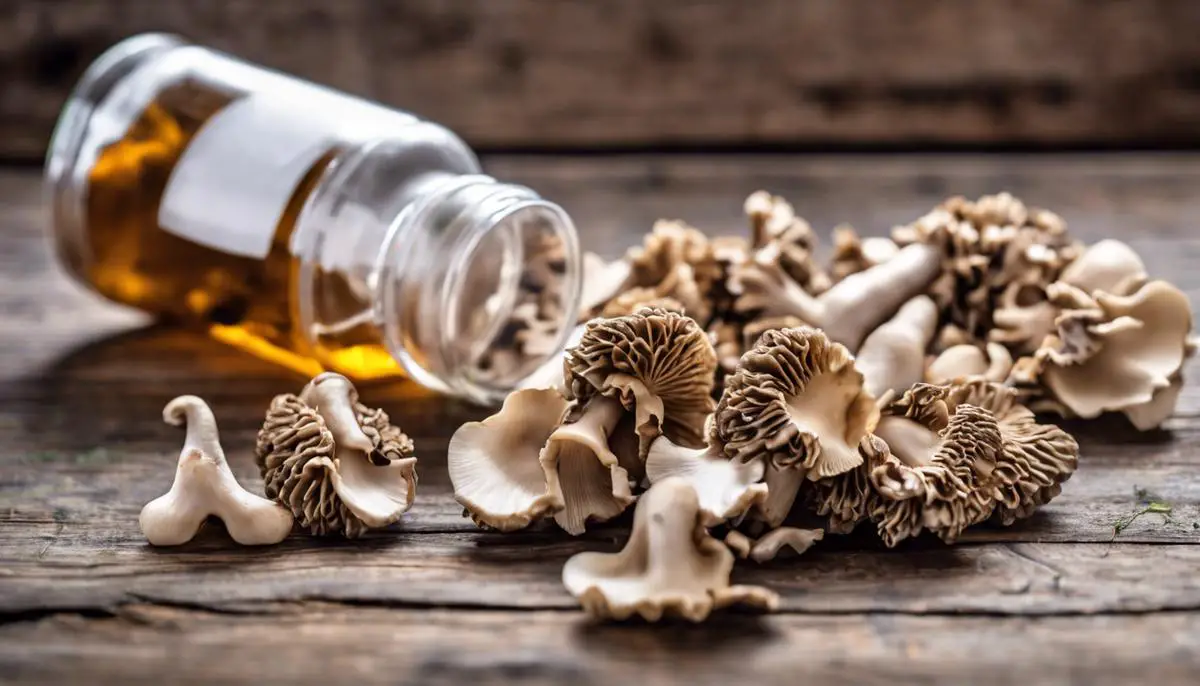
The Hen-of-the-woods stands as a testament to nature's generosity. Its presence invites us into a deeper understanding and appreciation of our natural surroundings, encouraging a harmonious interaction that nourishes both body and soul. This mushroom thrives as a symbol of resilience, offering itself as a gift to those willing to learn its secrets and respect its habitat.
- Hou Y, Ding X, Hou W. Composition and antioxidant activity of water-soluble oligosaccharides from Hericium erinaceus. Mol Med Rep. 2015;11(5):3794-3799.
- He X, Wang X, Fang J, et al. Structures, biological activities, and industrial applications of the polysaccharides from Hericium erinaceus (Lion's Mane) mushroom: A review. Int J Biol Macromol. 2017;97:228-237.
- Friedman M. Chemistry, Nutrition, and Health-Promoting Properties of Hericium erinaceus (Lion's Mane) Mushroom Fruiting Bodies and Mycelia and Their Bioactive Compounds. J Agric Food Chem. 2015;63(32):7108-7123.


